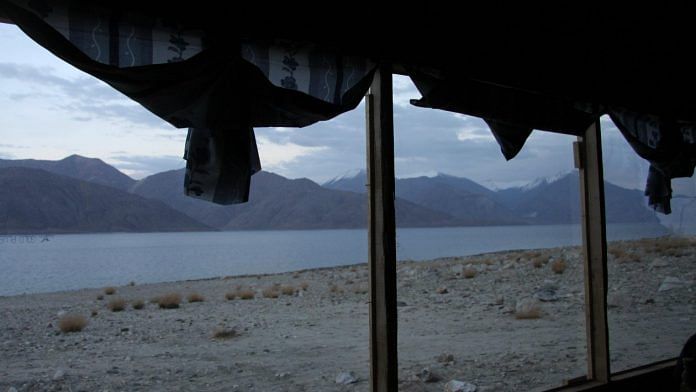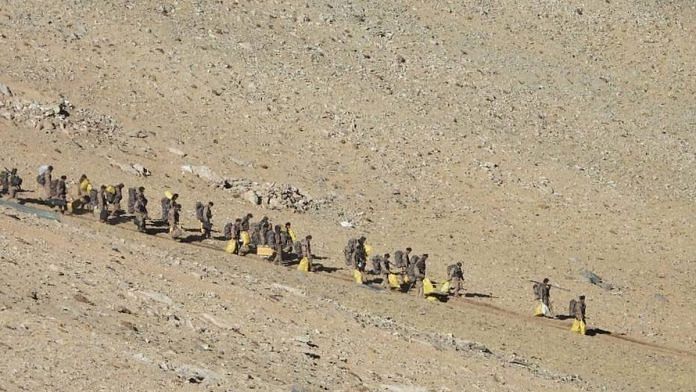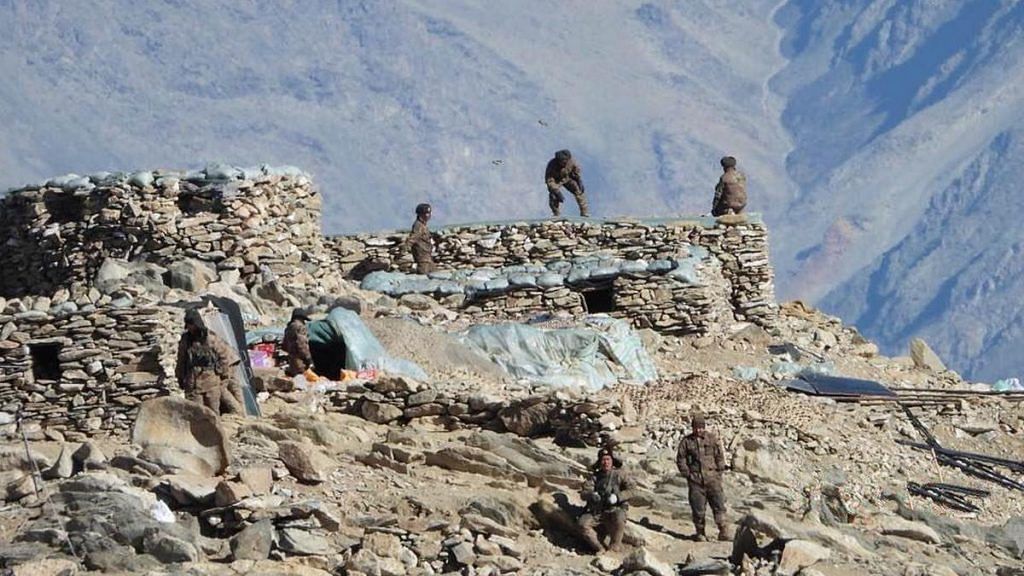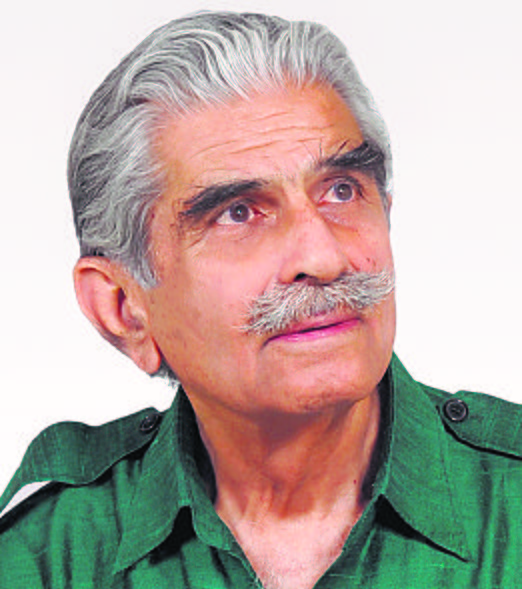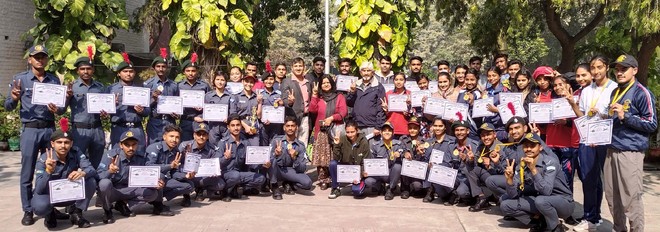Maj Gen Ashok K Mehta (retd)
Military Commentator
Keeping politics aside, relevant questions need to be asked about the ongoing LAC withdrawal plan. One of India’s worst fears of squandering gains on the ground for restoring the adverse situation on the LAC is turning out to be true. China looks set to get what it has wanted: not all, but most of it, including consummation of its 1959 claim line.
India has committed intelligence, operational and, now, negotiating lapses while managing the border standoff with China. After rejecting, it has conceded to a Chinese proposal of September 2020 containing a segregated agreement on phased disengagement, de-escalation and de-induction north and south of the Pangong Tso lake, according to which India will vacate the pivotal commanding heights on the Chushul range on its side of the LAC for a Chinese pullback from Finger 4 to Finger 8, an outright 8-km intrusion into Indian territory.
That is not all. Indian troops will move from Finger 4 to west of Finger 3. The space vacated will become a buffer zone in which patrolling will be suspended.
Still worse, there is no iron-clad linkage of this agreement with subsequent negotiations on the Gogra/Hot Springs, Demchok and especially Depsang where the Chinese have intruded 18 km and imposed a patrolling ban for the Indian forces.
After yielding so much, Defence Minister Rajnath Singh informed Parliament that he ‘did not concede anything’, which was clarified the next day by an MoD statement reading, ‘did not concede any territory.’ This is equivalent to the government’s earlier claims that the Chinese ‘have not intruded’ and ‘no territory has been lost’, when the facts on the ground were different.
The Chinese have imposed the Galwan model of disengagement weighted against India.
How can Singh describe the surrender of strategic space on the dominating Kailash heights as a tradeoff for withdrawal from the Fingers area astride the frozen lake along with the restriction of movement on the Indian side of the LAC as ‘not conceding’, especially after letting China cherrypick the withdrawal option?
In September 2020, the Chinese had posed this selective disengagement, but with the proviso that India, which had occupied Chushul heights on August 29/30, first withdraws from the heights and only then would the Chinese vacate the intrusion between Fingers 4 and 8.
At the time, many defence and strategic experts had warned the government against falling into China’s trap of conceding the one towering advantage it had gained and one which had unnerved the Chinese until the bottom line of restoration of status quo pre-April 2020 was achieved.
After a long rethink, China agreed to a simultaneous withdrawal, dropping the precondition that India, which moved first to occupy the Kailash range, should be the first to withdraw.
Clearly, the Chinese have brushed aside the demand for the restoration of status quo ante. The Chinese have never used the terminology of restoring status quo ante, but instead used restoring peace and tranquility in border areas. So far, the Chinese had categorically refused to discuss Depsang, which locks up the Indian strategic garrison of Daulat Beg Oldie (DBO).
Singh referred to this in Parliament: ‘The House should also know that there are still some outstanding issues with regards to deployment and patrolling at some other points along the LAC in eastern Ladakh.’
He did not name Depsang, a veritable dagger pointing towards DBO, the capture of which has for long been on the Chinese operational agenda. DBO links up with the 5,180-sq-km Shaqsgam valley — gifted by Pakistan to China in 1963 — which connects with the China-Pakistan Economic Corridor.
The loss of DBO will unhinge the India-occupied Siachen snow wall separating the Pakistani forces and the Chinese PLA. China has unilaterally established blocks at Depsang to prevent Indian troops from moving to their traditional patrolling points on the LAC.
The Congress has questioned the government on the selective disengagement, worrying that Singh’s statement gave little reassurance of the status quo ante as of April 2020.
It also lamented the fact that the government had agreed to withdraw from the dominating heights without any quid pro quo by China. When MP Adhir Ranjan Chowdhury sought a clarification in the Lok Sabha on these issues, strangely Parliamentary Affairs Minister Arjun Meghwal interrupted him, saying that he should be proud of the country’s defence forces.
In the Rajya Sabha debate, the Chair did not allow clarifications in order to uphold national unity and security. When former Defence Minister AK Antony rose to speak, Railway Minister Piyush Goyal rushed to urge his silence. During last year’s debate, the Chair, Vice President Venkaiah Naidu, had twice requested Singh to brief a select group of MPs on the situation along the LAC separately. But he has not done so till this day.
The government, which has demonstrated immense resolve by matching soldier for soldier and height for height, determined to stand up to China, seems to have suddenly cracked and, surprisingly, given in to Beijing’s pressure. Unacclimatised to deployment in winter, it was the PLA that was keen to pull back and descend from the heights which it had occupied for the first time after 1962. The speed and alacrity with which Chinese tanks, guns and troops pulled back last week was surprising.
To obfuscate the advantage-China withdrawal deal, government officials have been planting stories about the consummate skills of the national security trio — the Defence Minister, Foreign Minister and National Security Adviser — in achieving the breakthrough and restoring India’s image as well as its deterrence of defence, diplomacy and international partnerships.
The Chinese have a penchant for changing goalposts. They cite principles, with ‘those who advanced first must withdraw first’ being the most common and also the most flouted one.
The negotiations are likely to end up in China’s ‘two steps forward, one step backward’ approach, retaining Depsang, as predicted earlier, and Singh admitting to ‘substantially restoring the situation’ to that existing prior to the standoff.
By agreeing to the strategically stunted and segmented withdrawal plan north and south of the Pangong lake, and forfeiting the preponderant advantage of the commanding heights on the Chushul range for a couple of Fingers will probably go down as a ‘breakthrough blunder’ in ensuring that India’s quest for the restoration of status quo ante on the LAC is never met.
